| Listing 1 - 5 of 5 |
Sort by
|
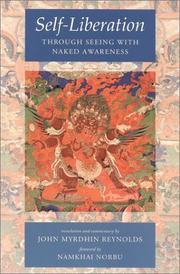
ISBN: 9781559391443 1559391448 Year: 2000 Publisher: Ithaca: Snow lion,
Abstract | Keywords | Export | Availability | Bookmark
 Loading...
Loading...Choose an application
- Reference Manager
- EndNote
- RefWorks (Direct export to RefWorks)
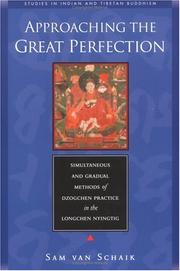
ISBN: 0861713702 9780861713707 Year: 2004 Publisher: Boston (Mass.) : Wisdom publications,
Abstract | Keywords | Export | Availability | Bookmark
 Loading...
Loading...Choose an application
- Reference Manager
- EndNote
- RefWorks (Direct export to RefWorks)
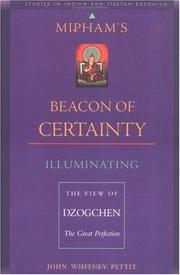
ISBN: 0861711572 9780861711574 Year: 2000 Publisher: Boston (Mass.) : Wisdom publications,
Abstract | Keywords | Export | Availability | Bookmark
 Loading...
Loading...Choose an application
- Reference Manager
- EndNote
- RefWorks (Direct export to RefWorks)
Rdzogs-chen (Rñiṅ-ma-pa). --- Rdzogs-chen (Rñiṅ-ma-pa). --- Rñiṅ-ma-pa (Sect) --- Rñiṅ-ma-pa (Sect) --- Doctrines. --- Rdzogs-chen (Rnin-ma-pa) --- Rnin-ma-pa (Sect) --- Rnin-ma-pa (Sect) - Doctrines.
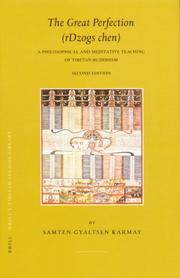
ISBN: 1281926027 9786611926021 9047419782 9789047419785 9789004151420 9004151427 9781281926029 661192602X Year: 2007 Volume: 11 Publisher: Leiden Boston Brill
Abstract | Keywords | Export | Availability | Bookmark
 Loading...
Loading...Choose an application
- Reference Manager
- EndNote
- RefWorks (Direct export to RefWorks)
The Great Perfection (rDzogs chen in Tibetan) is a philosophical and meditative teaching. Its inception is attributed to Vairocana, one of the first seven Tibetan Buddhist monks ordained at Samye in the eight century A.D. The doctrine is regarded among Buddhists as the core of the teachings adhered to by the Nyingmapa school whilst similarly it is held to be the fundamental teaching among the Bonpos, the non-Buddhist school in Tibet. After a historical introduction to Tibetan Buddhism and the Bon, the author deals with the legends of Vairocana (Part I), analysing early documents containing essential elements of the doctrine and comparing them with the Ch'an tradition. He goes on to explore in detail the development of the doctrine in the tenth and eleventh centuries A.D. (Part II). The Tantric doctrines that play an important role are dealt with, as are the rDzogs chen theories in relation to the other major Buddhist doctrines. Different trends in the rDzogs chen tradition are described in Part III. The author has drawn his sources mainly from early unpublished documents which throw light on the origins and development, at the same time also using a variety of sources which enabled him to explicate the crucial position which the doctrine occupies in Tibetan religions.
Rdzogs-chen --- Rdzogs-chen. --- Rdzogs-chen (Bonpo) --- Spiritual life --- Atiyoga --- Dzogchen --- Dzogschen --- Rdsogs-chen --- Rdzogs-chen (Rñiṅ-ma-pa) --- Rdzogs-pa-chen-pa --- Bon (Tibetan religion) --- Rnying-ma-pa (Sect) --- Buddhism --- Rdzogs-chen - Bon (Tibetan religion)
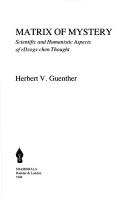
ISBN: 0877732914 9780394540733 9780877732914 0394540735 Year: 1984 Publisher: Boulder Shambhala
Abstract | Keywords | Export | Availability | Bookmark
 Loading...
Loading...Choose an application
- Reference Manager
- EndNote
- RefWorks (Direct export to RefWorks)
World-renowned Buddhist scholar Herbert V. Guenther here offers the first comprehensive study of the rDzogs-chen or Ati tradition of the Nyingma school of Tibetan Buddhism. Matrix of Mystery explores man's ability to preserve as well as transmit essential insights into the structure of reality.Utilizing a key root Buddhist scripture, the Guhyagarbha ("Matrix of Mystery"), along with dozens of commentarial Tibetan textual sources, Guenther presents the most profound teachings of the Buddhist tradition, which represent the culmination of religious thought and practice in Tibet. In relating these teachings in modern scientific and humanistic perspectives, he demonstrates how, in many cases, the traditional religious and modern secular perspectives on the nature of reality interface.Professor Guenther discusses the mandala and the deities that reside therein; the organizing principles of body, speech, mind, quality, and action, the three bodies of the buddha (trikaya); the inseparability of prajna and skillful means; and the complex field of Buddhist iconography. Throughout, quotations from numerous Tibetan sources are used to illustrate various teachings. His book will appeal to any serious student of Tibetan Buddhism.
Rdzogs-chen (Rñiṅ-ma-pa) --- Rñiṅ-ma-pa (Sect) --- Ningmapa (Sect) --- Nying-ma (Sect) --- Nying-ma-pa (Sect) --- Buddhist sects --- Atiyoga --- Dzogchen --- Dzogschen --- Rdsogs-chen --- Rdzogs-chen --- Rdzogs-pa-chen-pa --- Spiritual life --- Doctrines --- Rnying-ma-pa (Sect) --- Buddhism
| Listing 1 - 5 of 5 |
Sort by
|

 Search
Search Feedback
Feedback About UniCat
About UniCat  Help
Help News
News